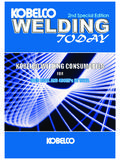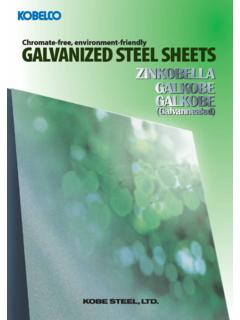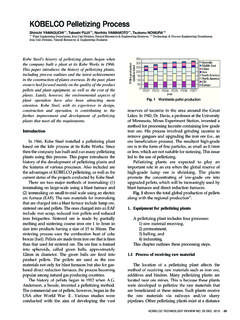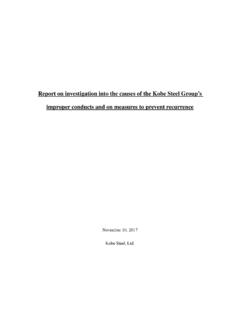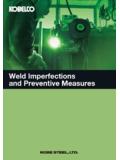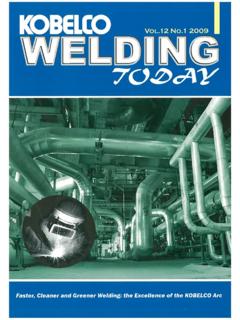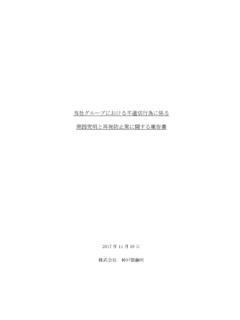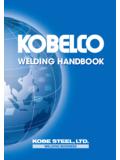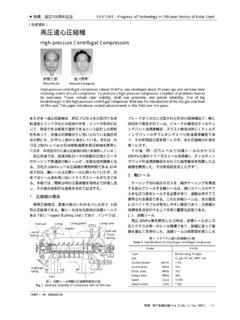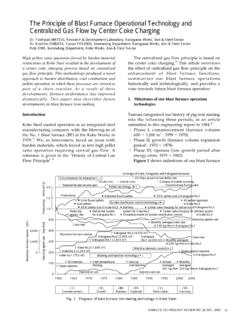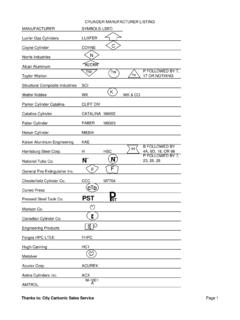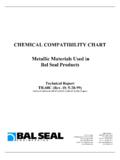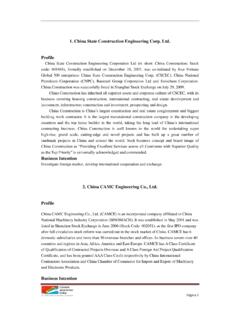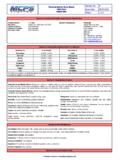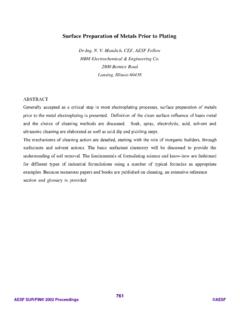Transcription of NOTES TO CONSOLIDATED FINANCIAL STATEMENTS
1 70 NOTES TO CONSOLIDATED FINANCIAL STATEMENTS Important Matters Forming the Basis of the Preparation of CONSOLIDATED FINANCIAL STATEMENTS 1. Matters Concerning the Scope of Consolidation Kobe steel , Ltd. (the Company ) has 210 subsidiaries, of which 166 subsidiaries are included in the scope of consolidation (the Group ). Names of major CONSOLIDATED subsidiaries are as follows. Nippon Koshuha steel Co., Ltd., Kobe Special Tube Co., Ltd., Shinko Kenzai, Ltd., Shinko Kobe Power Inc., Kobelco Logistics, Ltd., Shinko Bolt, Ltd., Sakai steel Sheets Works, Ltd., Shinko Engineering & Maintenance Co., Ltd., NI Welding Corporation, Kobe Welding of Qingdao Co., Ltd., Kobe Welding of Korea Co., Ltd., Kobelco & Materials Copper Tube Co., Ltd., Kobelco Automotive Aluminum Rolled Products (China) Co., Ltd., Kobe Aluminum Automotive Products (China) Co., Ltd., Kobe Aluminum Automotive Products, LLC, Kobe Precision Technology Sdn.
2 Bhd., Kobelco Compressors Corporation, Shinko Engineering Co., Ltd., Kobelco Compressors Manufacturing (Shanghai) Corporation, Kobelco Compressors America, Inc., Midrex Technologies, Inc., Kobelco Eco-Solutions Co., Ltd., Kobelco Eco-Maintenance Co., Ltd., Kobelco Construction Machinery Co., Ltd., KOBELCO Construction Machinery (East Japan) Co., Ltd., KOBELCO Construction Machinery (West Japan) Co., Ltd., Chengdu Kobelco Construction Machinery (Group) Co., Ltd., Chengdu Kobelco Construction Machinery Co., Ltd., Hangzhou Kobelco Construction Machinery Co., Ltd., Chengdu Kobelco Construction Machinery FINANCIAL Leasing Ltd., Thai Kobelco Construction Machinery Ltd., Kobelco International (S) Co., Pte. Ltd., Kobelco Construction Machinery Inc., Kobelco Construction Equipment India Pvt. Ltd., Kobelco Cranes Co., Ltd., Shinko Real Estate Co., Ltd., Kobelco Research Institute, Inc., Kobelco (China) Holding Co.
3 , Ltd., Kobe steel USA Holdings Inc. For fiscal year 2014, four companies, including Kobelco Machinery do Brazil Servi os Empresarais Ltda., are newly CONSOLIDATED and two companies, including KOBELCO AIR WATER CRYOPLANT, LTD. are excluded from the scope of consolidation mainly due to stock sales. 44 unconsolidated subsidiaries, including Shinkyo Kaiun Co., Ltd., are excluded from the scope of consolidation because the aggregated amounts of their total assets, sales, net income (corresponding to the Company s share), retained earnings (corresponding to the Company s share) and other indicators are insignificant compared to those of the CONSOLIDATED companies. 2. Matters Concerning the Application of the Equity Method Of the 44 unconsolidated subsidiaries and 58 affiliates, 44 companies are accounted for by the equity method. Names of major companies accounted for by the equity method are as follows.
4 OSAKA Titanium Technologies Co., Ltd., Shinko Wire Company, Ltd., Kansai Coke and Chemicals Co., Ltd., Japan Aeroforge, Ltd., Tesac Wirerope Co., Ltd., PRO-TEC Coating Company, Kobelco Angang Auto steel Co., Ltd., SRT Australia Pty Ltd., Wuxi Compressor Co., Ltd., Shinsho Corporation. For fiscal year 2014, two companies, , Kobelco Angang Auto steel Co., Ltd. and KOBELCO AIR WATER CRYOPLANT LTD. are newly accounted for by the equity 71 method and three companies, including KYOCERA Medical Corporation, are excluded from the application of equity method due to stock sales. 44 unconsolidated subsidiaries, including Shinkyo Kaiun Co., Ltd., and 14 affiliates, including Zirco Products Co., Ltd., are not accounted for by the equity method because the aggregated amounts of their net income (corresponding to the Company s share), retained earnings (corresponding to the Company s share) and other indicators are insignificant compared to those of the CONSOLIDATED companies and companies accounted for by the equity method.
5 3. Matters Concerning Accounting Policies (1) Basis and method for valuation of significant assets A. Basis and method for valuation of securities a) Held-to-maturity securities Cost basis. b) Available-for-sale securities i) Securities with market quotations Fair value basis, based on the market price etc. on the balance sheet date (with unrealized gains or losses, net of applicable taxes, stated in a separate component of net assets and cost of securities sold is primarily determined using the moving average method). ii) Securities without market quotations Cost basis, determined mainly using the moving average method. B. Basis for valuation of derivatives Fair value basis C. Basis and method for valuation of inventories Cost basis, determined principally by the average method for inventories in the Iron & steel Business, Welding and Aluminum & Copper Businesses, and by the specific identification method for finished goods and work in progress in the Machinery Business, Engineering Business, Kobelco Eco-Solutions, Kobelco Construction Machinery and Kobelco Cranes (the book value on the balance sheet may be written down to market value due to decline in the value).
6 (2) Depreciation and amortization method for significant depreciable assets a) Tangible fixed assets i) Owned fixed assets Primarily by the straight-line method. ii) Leased assets - Under finance leases that transfer ownership of the leased assets By the same method as the owned fixed assets. - Under finance leases that do not transfer ownership of the leased assets By the straight-line method over the respective lease term with no residual value. b) Intangible fixed assets Primarily by the straight-line method. For software for internal use, by the straight-line method over the estimated internal use lives (primarily five years). (3) Basis for recognition of significant allowances and provisions a) Allowance for doubtful accounts To provide for potential losses on doubtful accounts, allowance is made at an amount based on the actual bad debt ratio in the past for normal accounts, and estimated uncollectible amounts based on specific 72 collectability assessments for certain individual receivables, such as those with a possibility of default.
7 B) Provision for bonuses To provide for employee bonus payments, provision is made based on the estimated amounts to be paid. c) Provision for product warranties To provide for the Company s after-sales warranty cost payments for industrial machinery of the Machinery Business, plants of the Engineering Business and cast and forged steel products of the Iron & steel Business, provision is made at an estimated amount attributable to the fiscal year based on the actual warranty cost to sales ratio in the past, plus specifically estimated amount attributable to the fiscal year for certain individual cases. Certain CONSOLIDATED subsidiaries provide for after-sales warranty cost payments for finished goods at an estimated amount attributable to the fiscal year based on the actual warranty cost to sales ratio in the past. d) Provision for loss on construction contracts To provide for future losses on construction contracts, provision is made based on an estimated loss on construction contracts outstanding at the end of the fiscal year.
8 E) Provision for environmental measures For the cost of PCB waste treatment required by Law Concerning Special Measure against Promotion of Proper Treatment of Polychlorinated Biphenyl (PCB) Waste, provision is made at an estimated amount at the end of the fiscal year. f) Provision for structural reform related expenses For expenses expected to arise related to structural reform of Iron & steel Business, provision is made at an estimated amount at the end of the fiscal year. g) Provision for dismantlement related expenses For expenses expected to arise from dismantlement of equipment, such as the blast furnace, in relation to construction of the power station at Kobe Works, provision is made at an estimated amount at the end of the fiscal year. (4) Accounting method for retirement benefits To provide for payments of retirement benefits to employees, an asset or liability is established at an amount of projected benefit obligation net of the fair value of plan assets based on the estimated amounts at the end of the fiscal year.
9 In determining the retirement benefit liability, the benefit formula basis is adopted as the attribution method of the projected retirement benefit. Prior service costs are charged to income mainly using the straight-line method based on the average remaining service period of the employees. Actuarial differences are charged to income from the period following the period in which it arises mainly using the straight-line method based on the average remaining service period of the employees. Unrecognized prior service cost and unrecognized actuarial differences, net of applicable taxes, are stated in Remeasurements of defined benefit plans, net of tax in accumulated other comprehensive income of net assets. 73 (5) Basis for recognition of revenue For construction contracts of the Company s Machinery Business and Engineering Business and of certain CONSOLIDATED subsidiaries, revenues are recognized applying the percentage of completion method where the outcome of the contract up to the end of the fiscal year can be estimated reliably (with the estimate of percentage of completion based on the cost-to-cost method), or in case of not being estimated reliably, applying the completed contract method.
10 (6) Basis for translation of significant assets and liabilities denominated in foreign currencies into Japanese yen Monetary receivables and payables denominated in foreign currencies are translated into Japanese yen at the spot exchange rates as of the CONSOLIDATED balance sheet date, except for those hedged by foreign currency exchange contracts, with the resulting gains and losses recognized in income. Assets and liabilities of CONSOLIDATED foreign subsidiaries are translated into Japanese yen at the spot exchange rates as of the balance sheet date and revenues and expenses are translated into Japanese yen at average rates for the period, with the resulting gains and losses included in Foreign currency translation adjustments in net assets and Minority interests. (7) Principal method for hedge accounting A. Method for hedge accounting Deferred hedge method is applied. Assigning method is applied to monetary receivables and payables denominated in foreign currencies that are specifically covered by foreign currency exchange contracts and qualify for such assigning.
